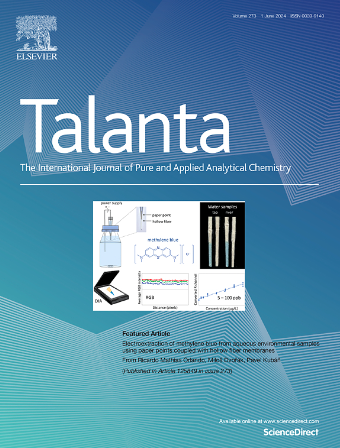未曾谋面:直接凝胶支撑液体萃取用于油漆层中有机着色剂的多技术表征
IF 5.6
1区 化学
Q1 CHEMISTRY, ANALYTICAL
引用次数: 0
摘要
本文章由计算机程序翻译,如有差异,请以英文原文为准。

To take unseen: direct gel-supported liquid extraction for multi-technique characterization of organic colourants in paint layers
The study of organic colourants employed in artworks is a fundamental topic for history and conservation research; however, the most critical aspect in such matter arises from the necessity of sampling. Instead of binding media and inorganic components, natural organic colourants often exhibit weak signals during non-invasive analyses, which can be easily masked in complex mixtures, such as paint layers. To overcome this problem, the preferred approach is to take a sample, extract the colourants and analyse them using specific analytical techniques. The proposed method of direct agar gel-supported liquid extraction, performed using a Pasteur pipette tip, offers a promising solution to this challenge. By extracting colourants without the need for paint sample removal, it minimises visible impact on the artwork while still providing sufficient material for spectroscopic and mass spectrometric characterization. The experimental approach, which involved mock-up of mixing different organic and inorganic pigments with different binders and subjecting them to artificial ageing, simulates real-world complex matrices and assesses the effectiveness of the extraction method. Photomicrographs were used to document the procedure's visible impact. Mass spectrometry and surface-enhanced Raman scattering spectroscopy, the techniques of choice for invasive analysis of organic colourants, were used on the analytes extracted from the gel. The method application on paint patches from historical catalogues, housed in the Stiftung Preußischer Kulturbesitz collection, adds practical relevance to the study and demonstrates the applicability of the technique to authentic artworks. The procedure enabled the identification of natural and synthetic colourants without compromising the integrity of the paint systems.
求助全文
通过发布文献求助,成功后即可免费获取论文全文。
去求助
来源期刊

Talanta
化学-分析化学
CiteScore
12.30
自引率
4.90%
发文量
861
审稿时长
29 days
期刊介绍:
Talanta provides a forum for the publication of original research papers, short communications, and critical reviews in all branches of pure and applied analytical chemistry. Papers are evaluated based on established guidelines, including the fundamental nature of the study, scientific novelty, substantial improvement or advantage over existing technology or methods, and demonstrated analytical applicability. Original research papers on fundamental studies, and on novel sensor and instrumentation developments, are encouraged. Novel or improved applications in areas such as clinical and biological chemistry, environmental analysis, geochemistry, materials science and engineering, and analytical platforms for omics development are welcome.
Analytical performance of methods should be determined, including interference and matrix effects, and methods should be validated by comparison with a standard method, or analysis of a certified reference material. Simple spiking recoveries may not be sufficient. The developed method should especially comprise information on selectivity, sensitivity, detection limits, accuracy, and reliability. However, applying official validation or robustness studies to a routine method or technique does not necessarily constitute novelty. Proper statistical treatment of the data should be provided. Relevant literature should be cited, including related publications by the authors, and authors should discuss how their proposed methodology compares with previously reported methods.
 求助内容:
求助内容: 应助结果提醒方式:
应助结果提醒方式:


